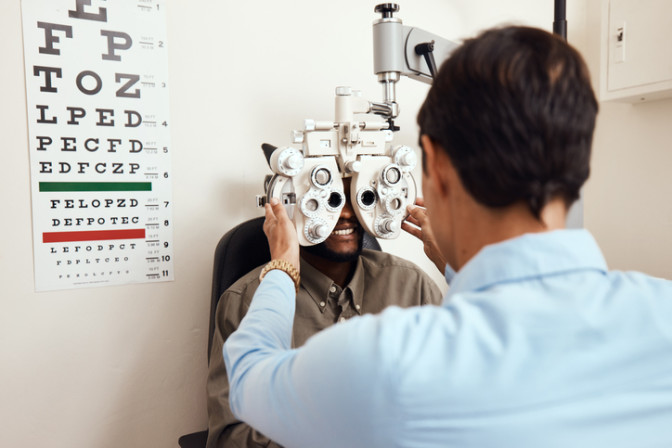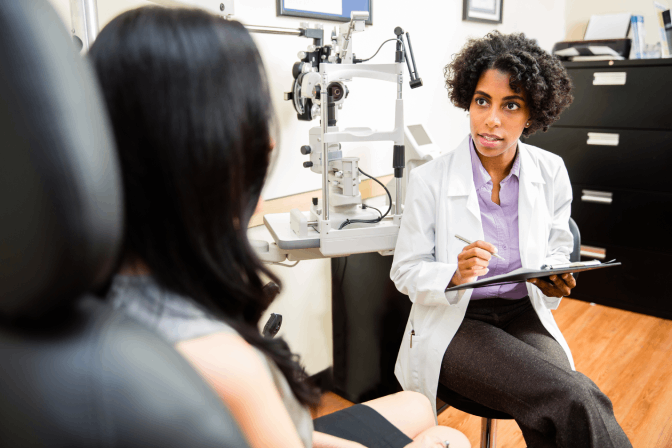Buy One, Get One 50% OFF Eyeglasses
* Restrictions apply. Ask a Team Member for details.

What is a Diabetic Eye Exam?
The importance of getting regular eye exams cannot be underestimated. More than just correcting your prescription, eye exams can reveal serious eye conditions before they start harming your vision.
This is even more true for those struggling with diabetes. Diabetics need to get checkups more frequently than other patients to prevent diabetic eye diseases that can quickly cause permanent vision damage with little warning. However, for those with type one or type two diabetes, regular eye exams won’t cut it. Diabetics need specialized diabetic eye exams. But what’s the difference between the two?
In this article, the experts at eyecarecenter pull on their decades of experience helping diabetic patients to explain the difference between these two exams and why it’s important for patients with diabetes to get specialized care.
A Look into Standard Eye Exams
Eye health is foundational to clear vision, making regular eye exams an indispensable routine for all. These exams are not just about fine-tuning your prescription; they're also about catching potential eye health issues before they escalate.

During a typical visit, you'll undergo a vision clarity assessment using a Snellen Eye Chart. You may recognize this as the chart with letters of different sizes on them. This tests your distance vision. This is usually followed by a precise prescription determination with a phoropter, the strange-looking pair of giant metal goggles your doctor puts on you before asking if option one or option two is better.
If your exam is comprehensive, expect pupil dilation for an in-depth inspection of your eyes. While dilation might cause temporary blurriness, it's a critical step for early detection of hidden conditions within your eye. Our tools for this deep dive include an ophthalmoscope for internal eye examinations and a slit lamp for a detailed look at the eye's surface structures. These instruments help us ensure your eyes are not just seeing well but are also healthy.
The Goal Behind Regular Eye Exams
The primary goal of regular eye exams is twofold: to update your prescription for optimal vision and to monitor your eye health for typical eye diseases. At eyecarecenter, we're dedicated to extending beyond basic vision checks, ensuring your eyes are in peak condition with comprehensive health assessments.

Understanding Diabetic Eye Exams
For our patients with diabetes, eye exams take on an added layer of importance. Diabetic eye exams incorporate all aspects of comprehensive eye assessments with a specialized focus on diabetes-related eye conditions. During a diabetic eye exam, you can expect:
Discussing Your Medical History
A detailed conversation about your diabetes and family health history sets the stage for a tailored examination, focusing on areas most impacted by diabetes. This is a crucial first step during any diabetic eye exam, as it lets us know if you have or are at risk for specific conditions, if you’ve received treatment, and how we should adjust treatments going forward.
Pupil Dilation for In-Depth Analysis
Like in a standard exam, we dilate your pupils to gain a clear view of the retina and other internal structures, critical for spotting signs of diabetic eye diseases such as diabetic retinopathy. The difference between regular eye exams and diabetic eye exams in this regard is the increased focus on the retina. This is typically the area diabetic eye diseases attack most due to the nature in which they damage blood vessels.
Optical Coherence Tomography (OCT)
This procedure isn’t always necessary, but it is a tool that allows doctors to get a better view of the inside of your eye. Think of it kind of like a CT scan for your eyes. OCT provides a detailed look at the retina on cross-sections, allowing us to identify any damage or changes early on. This is crucial for managing diabetes-related eye conditions and preventing vision loss.
Digital Retinal Imaging for Precise Monitoring
High-resolution photos of your retina help us catch early signs of diabetic eye diseases, offering a clear picture of your eye health over time. Your doctor may ask you to have these photos done before seeing you in the exam room. You’ll be instructed to sit in front of a special camera and have photos taken of your eyes. There will be a bright flash which leaves an afterimage in your eyes momentarily, but your vision should return to normal quickly.
Glaucoma Testing as a Preventive Measure
Due to the higher risk of glaucoma in individuals with diabetes, we measure your eye pressure to fend off this condition. The test is very simple. We’ll give you some numbing eye drops, and then touch a special instrument to your eye to measure ocular pressure. The whole procedure is painless and takes a matter of seconds.
Assessing Vision Changes
A standard vision check using a Snellen Eye Chart is part of the exam, but with a focus on detecting any diabetes-induced changes in your vision. If you experience a sudden drop in vision, it could indicate something is going on inside your eye that needs to be diagnosed and treated.
Why Diabetic Eye Exams Matter
Diabetic eye exams are meticulously designed to detect and manage conditions caused by diabetes, particularly focusing on the retina where such conditions predominantly manifest. Regular screenings are vital for early diagnosis, enabling prompt treatment to prevent significant damage or vision loss.
For those managing diabetes, keeping up with diabetic eye exams is a proactive measure in maintaining not just eye health but overall well-being, as diabetes-related eye conditions can progress unnoticed until they reach advanced stages at which point they cause permanent vision damage.
Partner with eyecarecenter for Diabetic Eye Care
Choosing eyecarecenter means entrusting your eye care to a dedicated team. Our practice spans 42 locations in North Carolina, equipped with state-of-the-art technology for diagnosing and treating diabetic eye conditions. We’re committed to delivering personalized care, whether you require specialized attention for diabetes-related eye issues or a routine eye exam.
Let us be your partner in maintaining clear vision and healthy eyes. Reach out to eyecarecenter today to schedule your appointment and take a crucial step towards comprehensive eye health.